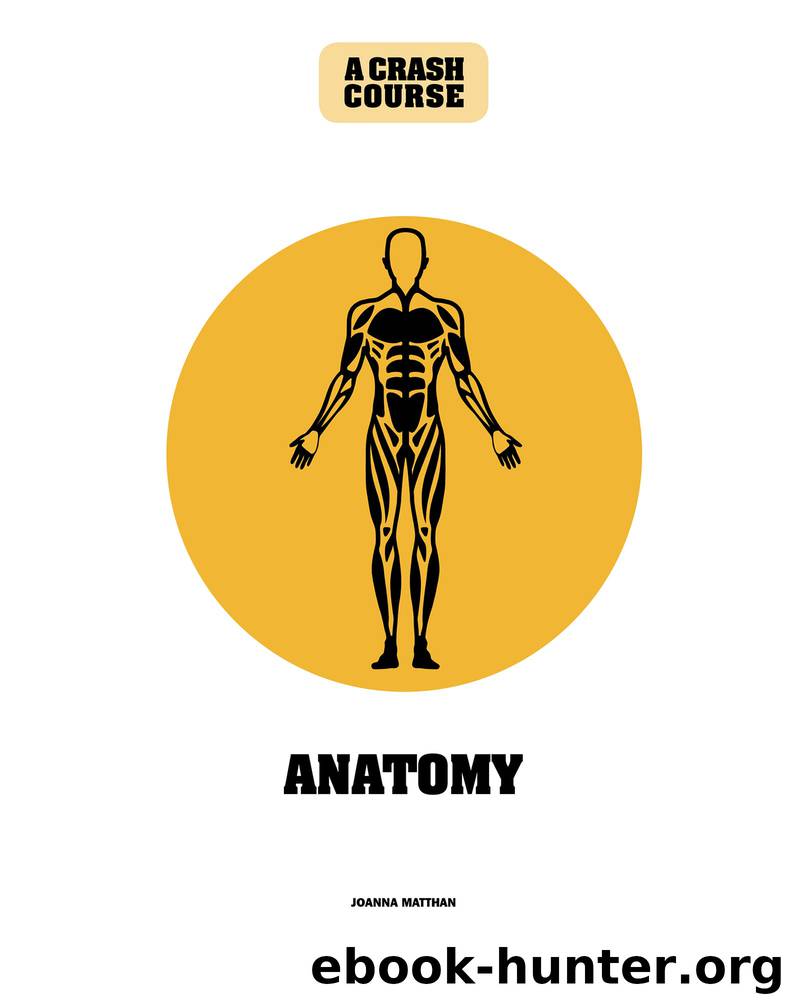Anatomy: A Crash Course by Joanna Matthan

Author:Joanna Matthan
Language: eng
Format: epub
Publisher: Ivy Press
Published: 2019-08-15T00:00:00+00:00
THE AORTA
GROSS ANATOMY | As wide as a garden hose and shaped like candy cane, the aorta is the largest artery in the body. It distributes oxygen-rich blood straight from the heart to every cell, organ, and structure in the body via a rich network of branching vessels. The artery begins at the base of the left ventricle of the heart, and blood is ejected out at high pressure via a three-part valve (aortic) that, once ejected, prevents blood from flowing backward. Two small openings in the wall are the origin of the heart’s own arterial supply, the coronary arteries. Blood is propelled upward via the short ascending aorta, then arches backward (arch of the aorta) and descends into the back of the chest cavity as the descending aorta, tucked away behind the heart. Three large branches off the arch of the aorta propel blood upward into the head, neck, and upper limbs. The descending aorta gives off numerous branches within the chest (thoracic aorta) and travels through an opening behind the diaphragm (aortic hiatus) to supply the abdomen (abdominal aorta). Bundles of arteries branch off to supply the abdominal organs, often giving a dual and overlapping supply. Above the pelvis, the aorta splits into the iliac arteries, which supply everything below this region.
CLINICAL ANATOMY | The wall of the aorta is made of three muscular layers. Abnormal widening (aneurysm) may happen anywhere along its course as a result of aging, untreated high blood pressure, or rare diseases. A tear may occur in the inner of the three linings, with blood leaking into the middle layer and creating a false passageway for blood flow. The arterial wall is further weakened as blood is diverted into this cul-de-sac, which becomes bigger and bigger. A split (aortic dissection) can spread and involve structures closer to the heart or the pericardial sac. All of these conditions require urgent surgical intervention, as a rupture can be deadly.
DISSECTION | A branch of the left vagus nerve, on its way through the neck and chest to the abdomen, loops underneath the arch of the aorta to travel upward to supply the larynx. This is an anatomical feature humans share with several other vertebrates. In giraffes, the nerve covers a distance of 15 ft (5 m); in humans this is less than 4 in. (10 cm).
Download
This site does not store any files on its server. We only index and link to content provided by other sites. Please contact the content providers to delete copyright contents if any and email us, we'll remove relevant links or contents immediately.
The Art of Coaching by Elena Aguilar(52196)
Thinking, Fast and Slow by Kahneman Daniel(11798)
The Art of Thinking Clearly by Rolf Dobelli(9919)
The 5 Love Languages: The Secret to Love That Lasts by Gary Chapman(9287)
Mindhunter: Inside the FBI's Elite Serial Crime Unit by John E. Douglas & Mark Olshaker(8707)
When Breath Becomes Air by Paul Kalanithi(8042)
Periodization Training for Sports by Tudor Bompa(7927)
Becoming Supernatural by Dr. Joe Dispenza(7838)
Turbulence by E. J. Noyes(7704)
Bodyweight Strength Training by Jay Cardiello(7679)
Therapeutic Modalities for Musculoskeletal Injuries, 4E by Craig R. Denegar & Ethan Saliba & Susan Saliba(7601)
The Road Less Traveled by M. Scott Peck(7281)
Nudge - Improving Decisions about Health, Wealth, and Happiness by Thaler Sunstein(7247)
Mastermind: How to Think Like Sherlock Holmes by Maria Konnikova(6940)
Enlightenment Now: The Case for Reason, Science, Humanism, and Progress by Steven Pinker(6877)
Win Bigly by Scott Adams(6829)
Kaplan MCAT General Chemistry Review by Kaplan(6601)
Why We Sleep: Unlocking the Power of Sleep and Dreams by Matthew Walker(6362)
The Way of Zen by Alan W. Watts(6290)
